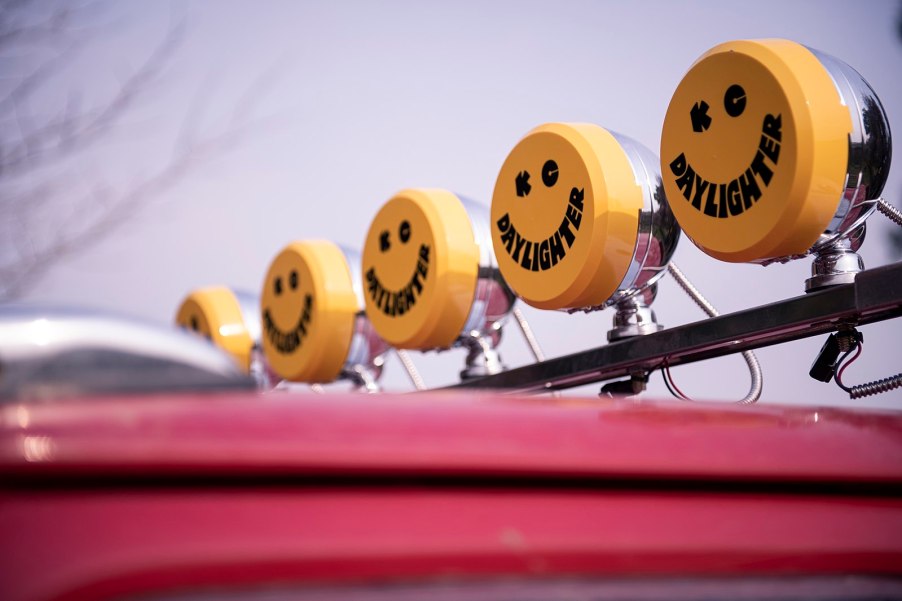
Science Says You Should Get Yellow Off-Road Driving Lights
Off-road lighting is cool. I’m not exactly sure why it adds instant cool points to your rig, but it does. A rack of KC Hilites will make any car or truck instantly cooler. What’s really fun is that the white light bars do not offer the same 1:1 coolness factor. The craziest part is that science backs this up. Science says you should get yellow off-road driving lights and not white ones.

Does the color of off-road lights really matter?
Yes, it does. According to research done by The Drive, yellow off-road auxiliary lights are better for seeing in the dark off-road and in the snow, rain, and fog. I didn’t know this when I installed my yellow PIAAs on my Mini Countryman, but it looks like my taste in cool-looking lights paid off.
Jonathan Klein from The Drive decided to bring in some heavy hitters to figure out which light hue is best for off-road visibility. So he called Dr. John Bullough, the Program director for the Department of Population Health Science and Policy and a staff member in the Light and Health Research Center at the Icahn School of Medicine at Mount Sinai, and Dr. John D Joannopoulos, the Francis Wright Davis Professor of Physics and Director of the Institute for Soldier Nanotechnologies at MIT, to see what’s what.
You might have heard the argument for yellow light is that it may reduce reflection and doesn’t scatter as much in the fog. According to Dr. Bullough, “is part of the reasoning behind the law in France that required headlights to be yellow up until the 1990s.” But that’s not actually what’s occurring.
Klein got Dr. Bullough to explain the following: “However, the effect of different wavelengths (colors) of light on scatter by water droplets in fog or rain (or from snow) is negligible,” Dr. Bullough added, saying, “The reason is that even for fog, the size of the particles is much larger than the wavelength of the light. When the particle size is similar in size to the wavelength (like molecules of gases in air), then short wavelengths (violet and blue) will scatter more than longer wavelengths (yellow and red). That’s why the sky is blue (the short wavelength light that appears blue is scattered more than the longer wavelengths), but clouds (which are made up of larger particles, more similar to fog) are white because all wavelengths are scattered equally.”
According to this science, yellow lights don’t work. But wait, I thought we said science claimed yellow lights are the best? They are, and here’s why; it’s not physics; it’s our biology.
Yellow rally lights work because of biology, not physics
“The extinction coefficient of light does not vary much in the visible or even through the IR (see attached paper),” Dr. Joannopoulus told Klein, “I think a more important issue of the wavelength of light is related to the fact that the pupil decreases in size as you go from red to blue wavelengths.”
To paraphrase the dense paragraphs of scientific block quotes, our eyes respond well to yellow lightwaves because our visual systems seem to prefer shorter wavelengths in low-light scenarios.
If you recall learning about rods and cones in high school science class, then you might remember we only use our cones to see in daylight situations. At night, we use both rods and cones to perceive light.
“Rods have their peak spectral sensitivity in the blue-green part of the spectrum, which corresponds to shorter wavelengths than the cones, which are maximally sensitive in the green-yellow part of the spectrum (longer wavelengths),” added Bullough, saying “Also, rods seem to be more sensitive to motion and blowing snowflakes and even fog, and falling raindrops can enhance the rod sensitivity. That means if the headlights contain more short-wavelength (blue/green) energy, they will make the blowing snow/fog/rain more visible (more distracting) than they would be under headlights that are yellowish.”
Yellow auxiliary lights work better than white lights
This is great news for those who want to drive cooler-looking cars and see better while doing it. The yellow-tinted lights do work, just not for the reasons the internet blowhards say they do.



